31st Fighter Group
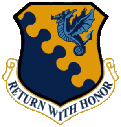

|
The 31st Pursuit Group, composed of a Headquarters squadron, and the 39th, 40th, and 41st Pursuit Squadrons was formed on February 1, 1940 at Selfridge Field, Michigan. They were initially equipped with P-39s. In January 1942 the 39th, 40th and 41st were transferred to the 35th PG and the 307th, 308th, and 309th Pursuit Squadrons were formed in their place to comprise the 31st. These three squadrons were equipped with the P-40B for three months then again re-equipped with the P-39. In June 1942 the Group's personnel were shipped to England with Headquarters, the 307th, and the 308th based at Atcham. The 309th was based at High Ercall. All three squadrons received Spitfire Vbs and assigned the squadron codes MX (307th), HL (308th), and WZ (309th). On August 1st the Group was deemed ready for action and the squadrons moved closer to the fighting, with the 307th moving to Biggin Hill, the 308th to Kenley, and the 309th to Westhampnett. Under RAF control, the squadrons sent sweeps to France during the first two weeks of August, took part in Circus 204 to Lille on the 17th and the big Dieppe Operation on the 19th. Group claims for the Dieppe Operation were 2 destroyed, 3 probable, and 1 damaged for the loss of 8 Spitfires. By the end of August the Group had all moved to the Westhampnett area and through September and early October participated in the usual patrols and Circuses of the time. The Circus operations were focused on Le Harve and Abbeville. On September 14 the 31st was transferred from the VIII AF to the XII AF. On Oct 13, 1942 the Group was declared non-operational and by the 23rd was on board ships bound for North Africa.
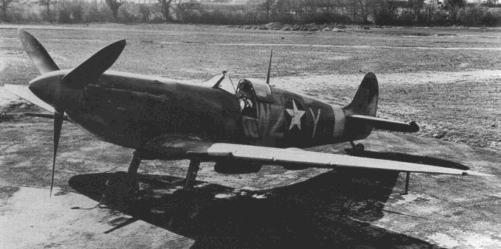 Operation TORCH, the invasion of North Africa, commenced on November 8, 1942. The 308th and 309th flew from Gibraltar into Tafaraoui Airfield, Algeria, with the 309th shooting down 3 French Dewoitine D.520s that were strafing the airfield as the group was landing. The group's ground echelons were disembarked at Arzeu on the 8th, and were trucked to Tafaraoui in the middle of the night. The 307th flew into Tafaraoui on the 9th. The Group was engaged in ground attack actions in their area up to November 11th when the French forces in the Oran area surrendered. By November 14 the group had moved the short distance to Le Senia and was tasked with capping Oran. For the rest of 1942 the rain and mud greatly limited operations, however the 307th did manage to move to Maison Blanche on December 21. By January 11, 1943 the 308th had moved to Casablanca, Morocco in order to cover the arrival of President Roosevelt and Prime Minister Winston Churchill. The 308th considered this assignment to be an honor. On Feb 7, 1943 the entire 31st FG assembled at Thelepte, Tunisia, their new home in the desert within 50 miles of the front. Conditions at Thelepte were very difficult, with the men living in shelters and dugouts, while the Luftwaffe frequently raided the base. The Germans were on the move and the second week of February found the group very busy escorting P-39s tasked with strafing the German convoys and positions. The 15th was an action packed day for the group starting with the 307th being strafed on the runway followed by the Group destroying 6 Me 109s & Fw 190s during the course of the day. On February 17, with Thelepte in imminent danger of being overrun by the Germans, the entire Group was ordered to evacuate immediately and forced to leave much of their supplies behind. During the next three weeks the 31st FG was scattered about North Africa in such places as Tebessa, Du Kouif, Youks-les-Bains, Canrobert, and Kalaa Djerda before they could reassemble at Thelepte. For the remainder of March through the first week of April the Group was principally tasked with escorting A-20s to the front. During this period the action was focused on El Guettar and LaFauconnerie and the 31st accounted for 15 Luftwaffe planes destroyed. On April 6 the 31st received its first Spitfire Mk IXs. The Germans were now on the run and the Group was moved to Djilma on the 7th, 15 miles from the front, then again on the 13th to Le Sers. Flying sweeps out of their new base at Le Sers, the 31st claimed 29 Luftwaffe planes destroyed by the time the last Germans surrendered in North Africa on May 11.
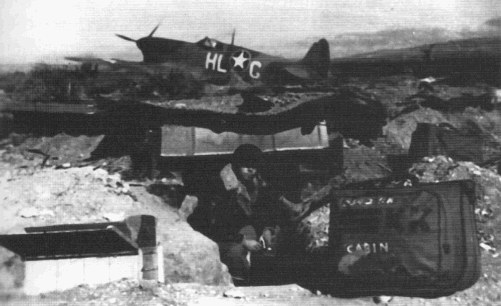 With the Germans out of North Africa, things slowed considerably for the 31st FG during the rest of May. Pilots were given rest leave and most of the Spitfire V's were replaced with Spitfire IXs and Spitfire Mk VIIIs. The 308th received the Mk VIIIs, which were nearly identical in performance to the Mk IX. By May 20 the Group had picked up and moved to Korba, a rough landing strip situated on the Gulf of Tunis, within site of the Allies next objective, Pantelleria. Pantelleria was a heavily fortified Island east of Cape Bon held by the Italians. Operational again by June 1st, the 31st was once again busy with escort missions to Pantelleria. The air battle really started to heat up on the 9th and by the time Pantelleria fell on June 11th the 31st FG had shot down 28 enemy aircraft, spanning three days, at little loss to themselves. After Pantelleria, June was a slow month and not altogether pleasant given the rough conditions at Korba, although many of the men took leave in nearby Tunis. On July 1st the Group moved yet again, this time to Gozo, a small Island situated 2 miles off Malta and 80 miles from Sicily - the next Allied objective. Operation Husky, the invasion of Sicily, commenced on July 10. The 31st was tasked with providing coverage of the invasion fleet. On the 11th, 7 enemy planes attacking Allied shipping were intercepted and destroyed by the 31st . The Group moved to Ponte Olivo, Sicily on the 14th. They bounced through Agregento and Palermo before settling in at Termini East on the Northern Coast of Sicily by August 1st. The Group accounted for 6 enemy planes downed during the second week of August. Sicily surrendered on August 17, 1943. Termini East was the nicest base the Group had been at for a long while, but their stay only lasted a month. On September 2nd the 31st moved to Milazzo, a dusty, terrible airstrip, in order to cover the landings at Salerno on the 9th. Quite a few of the Spitfires pranged trying to negotiate the poor airstrip at Milazzo. The 31st downed 6 German planes flying over the landing beaches at Salerno during the first half of September. By the 20th the situation was secure enough in Italy for the 31st to move to Monte Corvino, Italy, just five miles from Salerno. The activity at Monte Corvino consisted mostly of flying patrols over the Salerno beaches. That is until rain in the middle of the month turned the grass strip into a mud bog. On the 14th the 31st moved to Pomligliano which had a concrete runway. For the balance of October the Group flew bomber escort and infantry support missions to the front, along with many fruitless patrols. German air activity was nearly absent and the month ended with no scores for the Group. The most exiting event was the fighter sweeps to Rome on Oct 30 and 31st. Things picked up a bit during the second week of November when the Germans made a push towards Naples. German planes were seen again, in fact Pomligliano was bombed and strafed on two separate occasions on the 12th. In three days of fighting the 31st accounted for 6 German aircraft destroyed. The German advance stalled and the Allies consolidated their positions. For the balance of November the 31st was back to flying largely routine front line patrols, with the occasional Naval escort and sweep to Rome thrown in. Front line patrols were the most common mission type flown by the 31st through December; when the weather allowed for flying. Escorting of A-36 Invaders as well as B-25s, B-26s, and A-20s to the bombline was also a common occurrence. The missions took the 31st to the Liri and Garigliano Valleys and the Cassino Area. Flak was bad in the Cassino area and combat with German planes picked up during the second week of December. By the 15th the 31st had downed 11 Luftwaffe aircraft. The Cassino area was proving to be the hot spot. The constant front line patrolling was interrupted by a group move to Castel Volturno, a steel matted landing strip located in a march near Naples, on January 18, 1944. On January 22 the Invasion at Anzio began and the Group was tasked with providing cover for the invasion force and beachhead. Patrolling the Anzio beachhead was to become the normal routine and primary mission of the 31st right up to the end of March. Unlike the last few months of 1943 where the Luftwaffe was relatively scarce, the Anzio Invasion brought out the Luftwaffe in droves and the 31st saw a lot of combat. In January the group accounted for 30 Luftwaffe destroyed, most of them in and around the Anzio beachhead. The 307th moved to a dirt strip at Nettuno on Feb 1, but unrelenting German shellfire and air raids resulted in a move back to Castel Volturno by the middle of the month. This was not the first time the 31st was based just a little too close to the front lines. The ground echelon of the 307th were not fully extricated from the dreadful bombardment at Nettuno until the end of the month. Being part of a tactical air force, as the 31st was, meant missions over or near the front lines. When the weather allowed for it, the squadrons flew 3 or 4 missions a day escorting medium bombers to tactical targets and patrolling over the beachhead. During February, Anzio was a real hot spot and the allied ground forces were not making much headway. The 31st FG was doing their best to help out though and ended the month with 23 1/2 Luftwaffe planes destroyed. By March the German drive to push the allies off the Anzio beachhead had stalled and the Luftwaffe was not seen in as great a number as the previous month. The allies made a drive to take Cassino in mid March and the group split its patrol time between the two sectors. By the end of the month the group had racked up another 15 victories over the Luftwaffe. During the last week of March missions were curtailed as the pilots were sent to North Africa to shuttle back the group's new airplane; the P-51. Most of the pilots were not too thrilled at first to have to give up their Spitfires. From the time they first went into action in August 1942, up to March 1944 when the finally traded in the Spitfires for P-51s, the group had destroyed 194 1/2 enemy planes and had grown quite fond of the Spitfire.
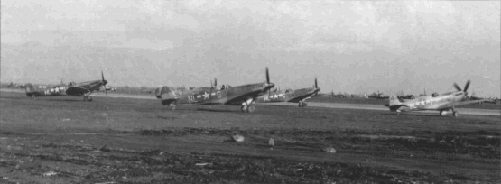 April brought big changes to the 31st. First they were transferred to the 15th Strategic Air Force, secondly they had re-equipped with the P-51B, and thirdly the Group had moved to San Servero, on the eastern side of Italy. The 15th Air Force was focusing its attention at this time on the enemy's railroad marshaling yards, aircraft factories and airfields. After two weeks of equipping, familiarization, and training missions in the new P-51 the 31st was tasked with bomber escort to these types of targets. In their Spitfire days the group's squadrons frequently flew missions independent of each other. The missions or patrols were over or near the front lines and an hour or two in duration. The bombers they escorted were usually light or medium types. Now with the P-51s, the 31st as a rule flew as a cohesive group escorting B-17 and B-24 heavy bombers. The distance flown was typically 500 miles or so and the mission time was twice that of what the Spitfire was capable. The big missions during April were to Turnal Severin and Ploesti (twice), Romania; Sofia, Bulgaria; Weiner Neustadt, Austria; Piombino, Milan, and Monfalcone, Italy; and Toulon, France. The group had big days during the Ploesti mission on the 21st and the Weiner Neustadt mission on the 23rd. Formations of as many as 50 German, Romanian, or Italian planes were encountered on some of these missions but by the end of April the 31st had downed 51 enemy aircraft. The 15th Air Force continued to pound Romania during May and the 31st participated in missions to Brasov, Bucharest, and Ploesti, Romania (three times this month). Weiner Neustadt, Austria was targeted again on the 10th and it was estimated to be defended by 120 German planes. Around the middle of May the 15th AF began to hit targets in Northern Italy in an effort to support the summer ground offensive. Missions to the marshaling yards at Lyons, St Etienne, and Montpellier, France during the last week of May were unopposed. This certainly was is marked contrast to the large number of enemy fighters the 31st was encountering over Austria and Romania. Big days for the group were 9 destroyed at Ploesti on the 5th, 9 destroyed at Munchendorf, Austria on the 24th and a whopping 14 destroyed in another mission to Weiner Neustadt on the 29th. The tally for May was 47 enemy planes destroyed. What a change season, plane and target make! In their first two months flying the P-51 to Romania, Austria, France and Northern Italy the 31st FG had accounted for 98 enemy planes destroyed.
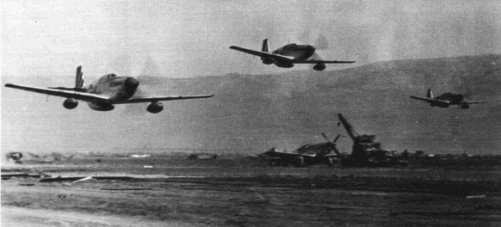 The enemy's marshaling yards in Romania, Hungary, France, and Italy continued to be targeted by the 15th Air Force during June. The 31st also flew escort for bombers targeting oil refineries at Treiste, Italy; Vienna, Austria; Ploesti, Romania; and Budapest, Hungary. Enemy airdromes were attacked at La Jasse, France, and Oberpfoffenhopen and Wessling (near Munich). The mission to Oberpfoffenhopen on the 9th of June was the first time the 31st flew inside Germany. The 31st began to receive new P-51Ds on the 17th of June and put them to good use, destroying 16 enemy aircraft during the June 26 mission to the Vienna, Austria airdrome & marshaling yards. By the end of the month the 31st had destroyed another 52 enemy aircraft. The missions to Germany picked up during July with the 31st FG flying escort on missions to Blechhammer, Munich, Brux, and Freidrichshafen (twice). Now familiar targets were hit multiple times: Budapest, Hungary 4 times; Ploesti 4 times; and Bucharest, Romania twice, A big show for the 31st was Operation Frantic III, a shuttle mission to Russia. 47 P-51s left San Servero on July 22nd and while enroute to Piryatin in the Ukraine covered P-38s attacking airfields in Romania. Flying out of Piryatin on the 25th the 31st attacked airfields in Poland, with the 307th having a field day destroying 21 Ju 87s. By the time the 31st FG had returned home on the 26th, they had destroyed 37 enemy aircraft and suffered no losses. This was an outstanding success which was rewarded with a Presidential Unit citation. The group totaled 82 enemy planes destroyed for the month of July 44. Missions to France by the 31st FG were met with very little enemy opposition. The 31st particitated in "Operation Anvil", the invasion of southern France during mid August, by flying escort for transports. There was still enemy opposition in Romania and Germany however. Ploesti was the target three more times in early August for the 31st where they shot down 15 enemy aircraft. Romania surrendered on the 23rd of August. The 31st was then tasked with escorting transports flying VIPs into Romania and POWs home. Three missions to Blechhammer yielded another 15 Luftwaffe destroyed. More Luftwffe were downed during a couple of missions to Czechoslovakia. All told the 31st destroyed 57 enemy aircraft during August.
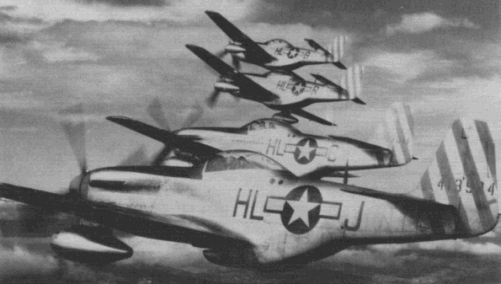 With Romania out of the war the 15th Air Force stepped up their attacks on Hungary. The 31st flew their first mission to Greece in September but came up empty. Munich and Odertal were still high priority targets but the Luftwaffe was not putting up much of a defense. Bad weather at the end of summer grounded the group. The 5 enemy planes shot down during September was very disappointing after the great success of the summer. With the coming of Autumn the weather in the MTO deteriorated and many days the missions were canceled and the group stood down. On days when the adverse weather let up the 31st flew escort on missions to hit the oil refineries at Vienna, Blechhammer and Brux, marshaling yards at Munich as well as strafing missions against airdromes and trains in Czechoslovakia. The 309th had a big day on October 16 when the squadron single handedly took on 100 plus German fighters at Brux, destroying 10 of them for no losses. Seeing the Luftwaffe in these numbers was becoming a rare thing and those raids that did get off in between bouts of bad weather were often unopposed. The oil refineries at Linz and Vienna, Austria were targeted by the 15th AF with the 31st flying escort four times during the first week of November. The Germans only bothered to try and intercept the raid on November 6, attacking with 30 to 40 Me 109s which the 31st drove off. Marshaling yards were targeted at Munich and Yugoslavia without much opposition. The 31st resorted to strafing locomotives and airdromes in order to find some action but these were inevitably costly. The second half of November was pretty much a wash out with all the rain and the Group only mangaged to destroy 28 planes during October and November combined. The weather improved sufficiently in December to allow missions to the oil refineries at Blechhammer, Odertal, Viennam, Brux, and Regensburg. It was during December that the 31st saw their first jet Me-262 with their first kill of a Me-262 coming on Dec 22. The squadrons of the 31st were now manned with about 50 pilots each which allowed for special missions escorting photo reconnaissance P-38s and Mosquitos on a near daily basis while the bulk of the group flew escort for the B-17s and B-24s to the oil refineries. The 31st only managed to fly on five missions during January of 1945. The Group escorted 15th Air Force bombers to targets at Trento, Klagenfurt, Vienna, Regensburg, and Mossbierbaum. For the remainer of the month the group was stood down because of bad weather. San Severo was hit by a foot of snow late in the month. No enemy planes were encountered let alone shot down during January. The Luftwaffe was scarce again during February with a only couple of Me 262s sighted during two separate reconnaissance escort missions and two Me 109s spotted during a bomber escort mission to Fiume. Other than these encounters the Luftwaffe did not offer any opposition to the missions flown by the 31st during February, consequently the group came up empty again in aerial victories. The 31st flew bomber escort for the 15th Air Force which continued to target oil refineries, marshaling yards and assorted rail targets. Missions to Mossbierbaum, Regensburg, Vienna, Amstetten, Bolzano, and Zagreb went unopposed. The 31st became more active in stafing ground targets after relieved of their escort duties and suffered the inevitable losses from ground fire. On March 3, 1945 the 31st FG moved to Mondolfo, 170 miles north of San Severo. Missions to Padua and Verona, Italy; Hegyshalom, Hungary; Regensburg and Weiner Neustadt were unopposed. Finally on the 18th of March the three month drought ended with the 31st downing two HE 111s near Lake Balaton, Hungary. The Group tangled with Me 262s on the mission to Muhldorf, Germay on the 19th but came up empty. On the 22nd the 31st claimed its second Me 262 victory during an escort mission to the Ruhland, Germany oil refinery. Berlin was the target on the 24th. This was the first time the 31st had flown to Berlin and they did it in style shooting down 5 Me-262s! The 31st was getting back into the swing of things and downed 6 FW 190s the next day. The 31st FG capped the month of March with a remarkable performance on the last day of March by shooting down 21 Luftwaffe planes. The 309th took on 30 ME 109s during a sweep to Prague, Czechoslovakia and shot 18 of them down in 20 minutes with no losses. In April, in a throw back to their Spitfire days, the 31st changed tactics and concentrated their efforts against tactical targets in Northern Italy. Four or five missions a day were flown by each squadron escorting medium bombers of the 12th Air Force and carrying out armed reconnaissance patrols in support of Allied Armies. The fighting in Italy ended on May 2 and the War in Europe offically ended May 8. The 31st Fighter Group ended the war as the top scoring allied fighter group in the Mediterranean Theater of Operations and the 5th highest overall for the USAAF with 570 1/2 confirmed aerial victories. The last of the 31st personnel shipped out for home on August 13, 1945. |